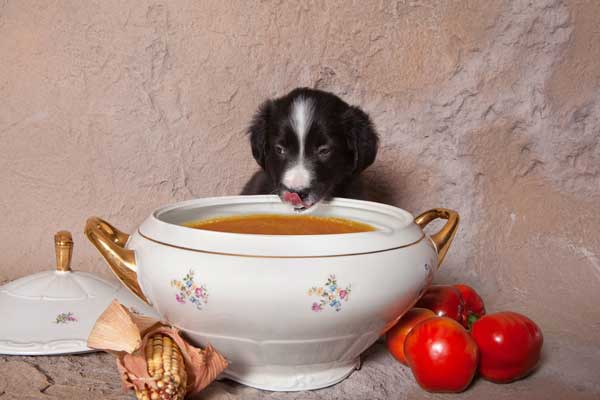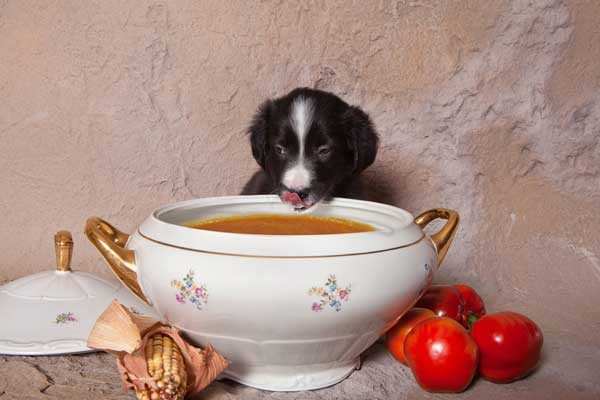Picture this: You’ve just peeled off your scarf, heavy coat, gloves, and snowshoes after spending the afternoon shoveling cold, wet snow from your driveway. Your mind drifts to images of the perfect food to thaw you out: a steaming cup of soup or perhaps a hearty, warm casserole. Have you ever noticed that as the seasons change, so does your taste in food?
Now that winter is in full swing, that cold pasta salad you craved last summer doesn’t seem as appealing. When temperatures plummet, warming foods just make sense; they’re like a cozy sweater for our insides. But can warm foods also help your dog beat the winter chill? “Dogs digest food in a very similar manner as people, so we can surmise that warm foods benefit them in the same way they benefit us,” said Babette Gladstein, VMD, owner of Animal Acupuncture in New York City.

Certain dogs, such as old and ill dogs, and flat-furred breeds, such as Chihuahuas, Weimaraners, Chinese Cresteds, Greyhounds, and German Pointers, are more susceptible to the chilling effect of cold temperatures. “These dogs may benefit even more from consuming warm foods on chilly days,” Gladstein said.
According to Gladstein, warm foods work their magic in a couple of ways. They provide an immediate sense of internal warmth as they travel from the mouth to the stomach. They also help to increase blood circulation. “When we are cold, everything in the body constricts, and the blood concentrates in the body’s trunk to warm and protect the internal organs,” Gladstein said. “Warm foods help reduce constriction, enabling the blood to flow away from the core to the extremities, which creates a sense of warmth.”
According to traditional Chinese medicine, warm foods are also quicker and easier to digest than cold foods. “The body needs to bring the temperature of food closer to its own internal temperature in order to efficiently digest it,” Gladstein said. “If the food is already warm, the body does not need to expend as much energy heating it and can get right down to the business of digestion and absorption.”
If you’ve ever stepped into a bakery and began salivating with hunger at the aroma of freshly baked bread wafting through the air, then you know that scent plays a powerful role in inducing appetite.
Now imagine you are a dog, with a sense of smell that is tens of thousands of times more sensitive than a human’s. “The better a food smells to a dog, the more appetizing it becomes,” Gladstein said. “Warm foods release aromatic vapors, which stimulate a dog’s desire to eat.”
You can heat up commercial canned or kibble dog food by mixing some gently warmed water to create an enticing cold-weather “stew.” If you feed dehydrated or freeze-dried food, simply rehydrate the mix with warmer water than usual.
How do you know if your dog feels toasty after chowing down on a warm meal? Observe his body posture, Gladstein said. “A dog will curl up to keep warm just as we do, so if he sprawls out after his meal, he likely is not cold.”
Soup for two!
According to traditional Chinese medicine, every food possesses an energetic quality that makes it either warming or cooling. Dog-friendly warming foods include oats (be sure they are gluten-free), quinoa, rice, kale, squash, and coconut.
Want to share a warm meal with your dog? My warming Thai-style butternut squash soup will have you both licking the bowl clean!
Just be certain that the temperature of your dog’s portion is warm but not hot. My favorite “thermometer” is my index finger. If I can dip my finger in the food and comfortably hold it there, then it’s ready for my dog Chase to lap up!
Ingredients
- 1 10-ounce bag of frozen butternut squash (preferably organic)
- 1⁄4 cup canned, unsweetened light coconut milk (preferably organic)
- 1 tablespoon maple syrup
- 1 1⁄4 cups water (preferably filtered or spring water)
- 1⁄8 teaspoon cinnamon
- 1⁄8 teaspoon turmeric
- 1⁄8 teaspoon ginger
- Pinch of ground black pepper
Directions
Pour butternut squash into a medium-sized saucepan. Add 1⁄4 cup of the water. Bring mixture to a boil, and reduce the heat to medium. Cook until the squash is completely tender, stirring frequently and breaking up the chunks of squash with a wooden spoon for about 10 minutes.
When the squash is fully cooked, stir in the coconut milk, maple syrup, and remaining water. Stir to fully integrate. Add the cinnamon, turmeric, ginger, and ground black pepper, and stir. For a smoother consistency, use an immersion blender to puree the mixture or transfer the soup to a standing blender, puree, and return it to the pot.
Makes approximately 2 cups.
Read more by Diana Laverdure-Dunetz:










